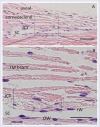The Juxtacanalicular Region of Ocular Trabecular Meshwork: A Tissue with a Unique Extracellular Matrix and Specialized Function
- PMID: 24364042
- PMCID: PMC3867143
The Juxtacanalicular Region of Ocular Trabecular Meshwork: A Tissue with a Unique Extracellular Matrix and Specialized Function
Abstract
The trabecular meshwork (TM) is a filter-like tissue located in the anterior segment of the eye. It is composed of a series of fenestrated beams through which aqueous humor flows to exit the anterior chamber via Schlemm's canal. The primary function of the TM is to regulate the flow of aqueous humor in order to establish intraocular pressure (IOP). Dysregulated aqueous humor outflow causes elevated IOP, which is a primary risk factor for glaucoma. The region of the TM implicated in establishing IOP lies adjacent to Schlemm's canal and is called the juxtacanalicular tissue (JCT) or cribriform region. Recent advanced light microscopy studies suggest that the JCT can be subdivided into inner and outer zones based on the localization of certain extracellular matrix (ECM) molecules. By comparing the ECM of the JCT to other connectives tissues and disease processes, this review outlines the evidence for two new concepts in TM biology: (1) continuous maintenance ECM remodeling, which may be critical in order to preserve open aqueous humor flow channels by releasing trapped debris and associated ECM fragments from the outflow pathways; (2) the JCT ECM as a barrier to functionally isolate the aqueous outflow channels. The ECM surrounding the outflow channels in the JCT may function to sequester small active regulatory molecules and prevent them from aberrantly modulating outflow resistance. These adaptations point to a distinctive tissue that has evolved transient ECM remodeling processes in order to regulate aqueous humor outflow and maintain rigorous control of IOP.
Keywords: Extracellular matrix; Glaucoma; Intraocular pressure; Outflow resistance; Trabecular meshwork.
Figures

Similar articles
-
The exit strategy: Pharmacological modulation of extracellular matrix production and deposition for better aqueous humor drainage.Eur J Pharmacol. 2016 Sep 15;787:32-42. doi: 10.1016/j.ejphar.2016.04.048. Epub 2016 Apr 23. Eur J Pharmacol. 2016. PMID: 27112663 Review.
-
Extracellular matrix in the trabecular meshwork: intraocular pressure regulation and dysregulation in glaucoma.Exp Eye Res. 2015 Apr;133:112-25. doi: 10.1016/j.exer.2014.07.014. Exp Eye Res. 2015. PMID: 25819459 Free PMC article. Review.
-
Normal and glaucomatous outflow regulation.Prog Retin Eye Res. 2021 May;82:100897. doi: 10.1016/j.preteyeres.2020.100897. Epub 2020 Aug 11. Prog Retin Eye Res. 2021. PMID: 32795516 Free PMC article. Review.
-
High-resolution modeling of aqueous humor dynamics in the conventional outflow pathway of a normal human donor eye.Comput Methods Programs Biomed. 2025 Mar;260:108538. doi: 10.1016/j.cmpb.2024.108538. Epub 2024 Nov 29. Comput Methods Programs Biomed. 2025. PMID: 39644783
-
Modeling the biomechanics of the conventional aqueous outflow pathway microstructure in the human eye.Comput Methods Programs Biomed. 2022 Jun;221:106922. doi: 10.1016/j.cmpb.2022.106922. Epub 2022 May 29. Comput Methods Programs Biomed. 2022. PMID: 35660940 Free PMC article.
Cited by
-
Trabecular Meshwork Regeneration - A Potential Treatment for Glaucoma.Curr Ophthalmol Rep. 2019 Jun;7(2):80-88. doi: 10.1007/s40135-019-00203-2. Epub 2019 Apr 16. Curr Ophthalmol Rep. 2019. PMID: 31316866 Free PMC article.
-
Pathogenesis of glaucoma: Extracellular matrix dysfunction in the trabecular meshwork-A review.Clin Exp Ophthalmol. 2022 Mar;50(2):163-182. doi: 10.1111/ceo.14027. Epub 2022 Jan 17. Clin Exp Ophthalmol. 2022. PMID: 35037377 Free PMC article. Review.
-
Role of Fibronectin in Primary Open Angle Glaucoma.Cells. 2019 Nov 26;8(12):1518. doi: 10.3390/cells8121518. Cells. 2019. PMID: 31779192 Free PMC article. Review.
-
Dexamethasone Modulates the Dynamics of Wnt Signaling in Human Trabecular Meshwork Cells.Vision (Basel). 2023 May 25;7(2):43. doi: 10.3390/vision7020043. Vision (Basel). 2023. PMID: 37368816 Free PMC article.
-
ROCK inhibitors beneficially alter the spatial configuration of TGFβ2-treated 3D organoids from a human trabecular meshwork (HTM).Sci Rep. 2020 Nov 20;10(1):20292. doi: 10.1038/s41598-020-77302-9. Sci Rep. 2020. PMID: 33219246 Free PMC article.
References
-
- Tamm ER. The trabecular meshwork outflow pathways: structural and functional aspects. Exp Eye Res. 2009;88:648–655. - PubMed
-
- Grierson I, Lee WR, Abraham S, Howes RC. Associations between the cells of the walls of Schlemm’s canal. Albrecht Von Graefes Arch Klin Exp Ophthalmol. 1978;208:33–47. - PubMed
-
- Inomata H, Bill A, Smelser GK. Aqueous humor pathways through the trabecular meshwork and into Schlemm’s canal in the cynomolgus monkey (Macaca irus). An electron microscopic study. Am J Ophthalmol. 1972;73:760–789. - PubMed
Grants and funding
LinkOut - more resources
Full Text Sources
Other Literature Sources
